Products
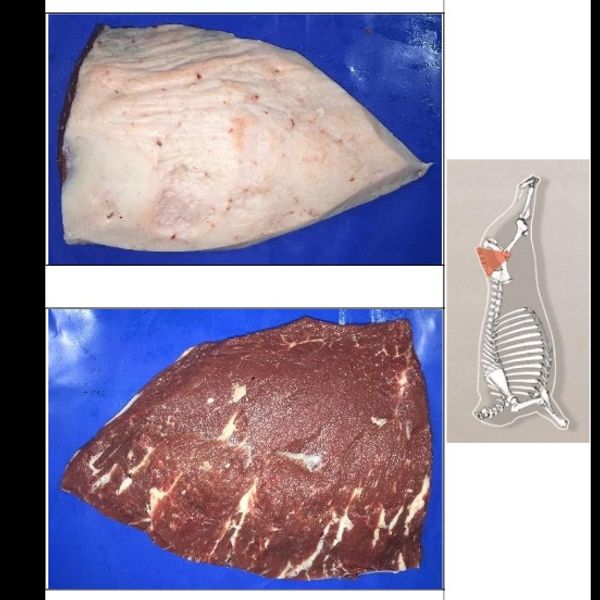
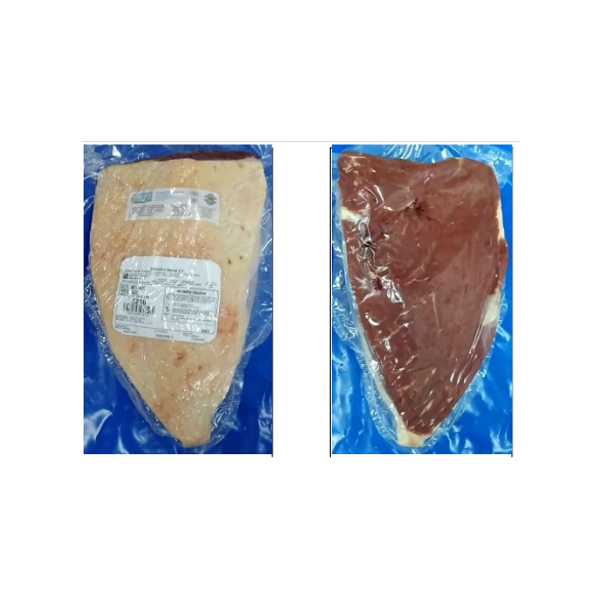
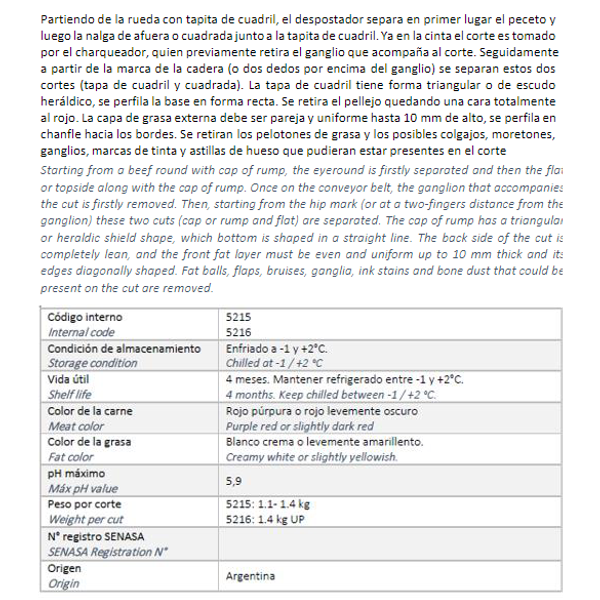
TAPA DE CUADRIL / CAP OF RUMP
Partiendo de la rueda con tapita de cuadril, el despostador separa en primer lugar el peceto y
luego la nalga de afuera o cuadrada junto a la tapita de cuadril. Ya en la cinta el corte es tomado
por el charqueador, quien previamente retira el ganglio que acompaña al corte. Seguidamente
a partir de la marca de la cadera (o dos dedos por encima del ganglio) se separan estos dos
cortes (tapa de cuadril y cuadrada). La tapa de cuadril tiene forma triangular o de escudo
heráldico, se perfila la base en forma recta. Se retira el pellejo quedando una cara totalmente
al rojo. La capa de grasa externa debe ser pareja y uniforme hasta 10 mm de alto, se perfila en
chanfle hacia los bordes. Se retiran los pelotones de grasa y los posibles colgajos, moretones,
ganglios, marcas de tinta y astillas de hueso que pudieran estar presentes en el corte
Starting from a beef round with cap of rump, the eyeround is firstly separated and then the flat
or topside along with the cap of rump. Once on the conveyor belt, the ganglion that accompanies
the cut is firstly removed. Then, starting from the hip mark (or at a two-fingers distance from the
ganglion) these two cuts (cap or rump and flat) are separated. The cap of rump has a triangular
or heraldic shield shape, which bottom is shaped in a straight line. The back side of the cut is
completely lean, and the front fat layer must be even and uniform up to 10 mm thick and its
edges diagonally shaped. Fat balls, flaps, bruises, ganglia, ink stains and bone dust that could be
present on the cut are removed.
luego la nalga de afuera o cuadrada junto a la tapita de cuadril. Ya en la cinta el corte es tomado
por el charqueador, quien previamente retira el ganglio que acompaña al corte. Seguidamente
a partir de la marca de la cadera (o dos dedos por encima del ganglio) se separan estos dos
cortes (tapa de cuadril y cuadrada). La tapa de cuadril tiene forma triangular o de escudo
heráldico, se perfila la base en forma recta. Se retira el pellejo quedando una cara totalmente
al rojo. La capa de grasa externa debe ser pareja y uniforme hasta 10 mm de alto, se perfila en
chanfle hacia los bordes. Se retiran los pelotones de grasa y los posibles colgajos, moretones,
ganglios, marcas de tinta y astillas de hueso que pudieran estar presentes en el corte
Starting from a beef round with cap of rump, the eyeround is firstly separated and then the flat
or topside along with the cap of rump. Once on the conveyor belt, the ganglion that accompanies
the cut is firstly removed. Then, starting from the hip mark (or at a two-fingers distance from the
ganglion) these two cuts (cap or rump and flat) are separated. The cap of rump has a triangular
or heraldic shield shape, which bottom is shaped in a straight line. The back side of the cut is
completely lean, and the front fat layer must be even and uniform up to 10 mm thick and its
edges diagonally shaped. Fat balls, flaps, bruises, ganglia, ink stains and bone dust that could be
present on the cut are removed.
Boneless
Fresh
As per customer's request
Portion Cut
Origin
아르헨티나
+ 1


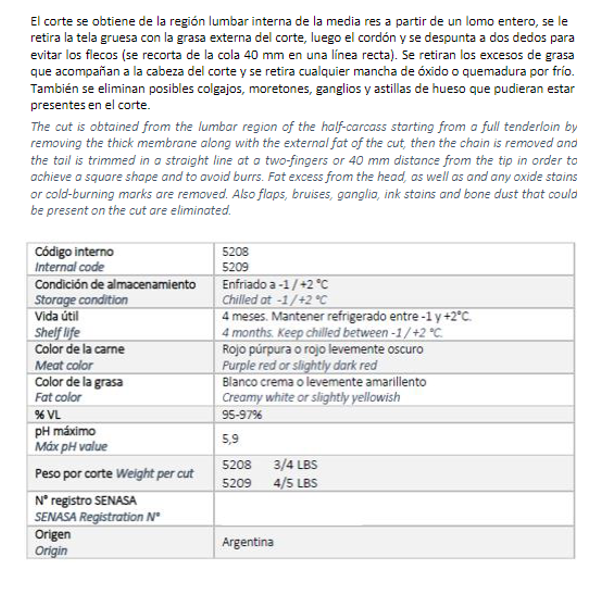
LOMO SIN CORDÓN / TENDERLOIN CHAIN OFF
El corte se obtiene de la región lumbar interna de la media res a partir de un lomo entero, se le
retira la tela gruesa con la grasa externa del corte, luego el cordón y se despunta a dos dedos para
evitar los flecos (se recorta de la cola 40 mm en una línea recta). Se retiran los excesos de grasa
que acompañan a la cabeza del corte y se retira cualquier mancha de óxido o quemadura por frío.
También se eliminan posibles colgajos, moretones, ganglios y astillas de hueso que pudieran estar
presentes en el corte.
The cut is obtained from the lumbar region of the half-carcass starting from a full tenderloin by
removing the thick membrane along with the external fat of the cut, then the chain is removed and
the tail is trimmed in a straight line at a two-fingers or 40 mm distance from the tip in order to
achieve a square shape and to avoid burrs. Fat excess from the head, as well as and any oxide stains
or cold-burning marks are removed. Also flaps, bruises, ganglia, ink stains and bone dust that could
be present on the cut are eliminated
retira la tela gruesa con la grasa externa del corte, luego el cordón y se despunta a dos dedos para
evitar los flecos (se recorta de la cola 40 mm en una línea recta). Se retiran los excesos de grasa
que acompañan a la cabeza del corte y se retira cualquier mancha de óxido o quemadura por frío.
También se eliminan posibles colgajos, moretones, ganglios y astillas de hueso que pudieran estar
presentes en el corte.
The cut is obtained from the lumbar region of the half-carcass starting from a full tenderloin by
removing the thick membrane along with the external fat of the cut, then the chain is removed and
the tail is trimmed in a straight line at a two-fingers or 40 mm distance from the tip in order to
achieve a square shape and to avoid burrs. Fat excess from the head, as well as and any oxide stains
or cold-burning marks are removed. Also flaps, bruises, ganglia, ink stains and bone dust that could
be present on the cut are eliminated
Boneless
Fresh
As per customer's request
Portion Cut
Origin
아르헨티나
+ 1



CORAZÓN DE CUADRIL / EYE OF RUMP
Boneless
Fresh
As per customer's request
Portion Cut
Origin
아르헨티나
+ 1

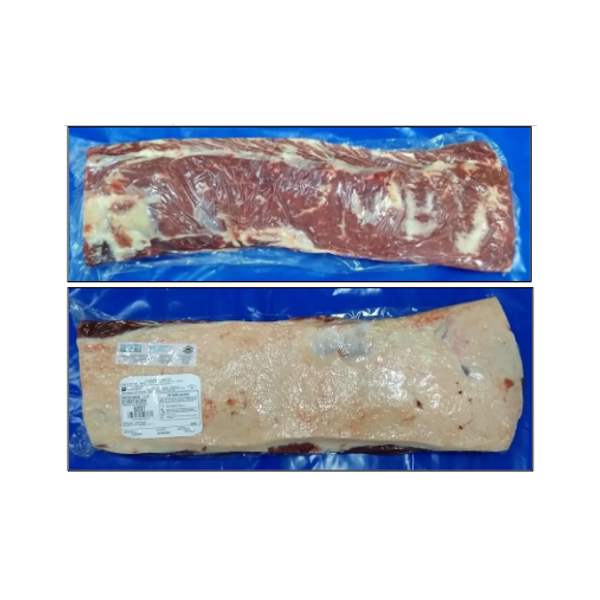

BIFE ANGOSTO CON CORDÓN / STRIPLOIN CHAIN ON
El corte es un músculo que se obtiene de la región dorso-lumbar de la media res, el músculo se
extiende desde la articulación de la cadera hasta alcanzar 3 a 4 costillas. El corte se separa del
basamento óseo en mesa y es liberado a la cinta donde es tomado por los charqueadores. Se
selecciona un corte con una contextura regular a buena. No extraen el cordón, y no retiran el
backstrap. La solapa no se descubre y se deja restos de la cadena (restos del corte vacío). Se
encuadran los extremos y se perfila la capa de grasa (1 cm). Debe haber ausencia de cartílagos
y restos óseos, marcas de sellos, manchas de tinta, aserrín, coágulos, nervios. Los bordes de de
la capa de grasa deben ser perfilados prolijamente.
This cut is obtained from the lumbar region of the half-carcass. The muscle extends along the
external side from the hip’s articulation until it reaches 3 to 4 ribs. The cut must present regular
to good conformation. Remains of flank must be cut off completely. The chain must not be
extracted and the backstrap or silver cover not removed. Fat balls, flaps, ink stains, bruises, bone
dust, cartilage remain must be removed.
extiende desde la articulación de la cadera hasta alcanzar 3 a 4 costillas. El corte se separa del
basamento óseo en mesa y es liberado a la cinta donde es tomado por los charqueadores. Se
selecciona un corte con una contextura regular a buena. No extraen el cordón, y no retiran el
backstrap. La solapa no se descubre y se deja restos de la cadena (restos del corte vacío). Se
encuadran los extremos y se perfila la capa de grasa (1 cm). Debe haber ausencia de cartílagos
y restos óseos, marcas de sellos, manchas de tinta, aserrín, coágulos, nervios. Los bordes de de
la capa de grasa deben ser perfilados prolijamente.
This cut is obtained from the lumbar region of the half-carcass. The muscle extends along the
external side from the hip’s articulation until it reaches 3 to 4 ribs. The cut must present regular
to good conformation. Remains of flank must be cut off completely. The chain must not be
extracted and the backstrap or silver cover not removed. Fat balls, flaps, ink stains, bruises, bone
dust, cartilage remain must be removed.
Boneless
Fresh
Portion Cut
Origin
아르헨티나
Production Capacity
1 /


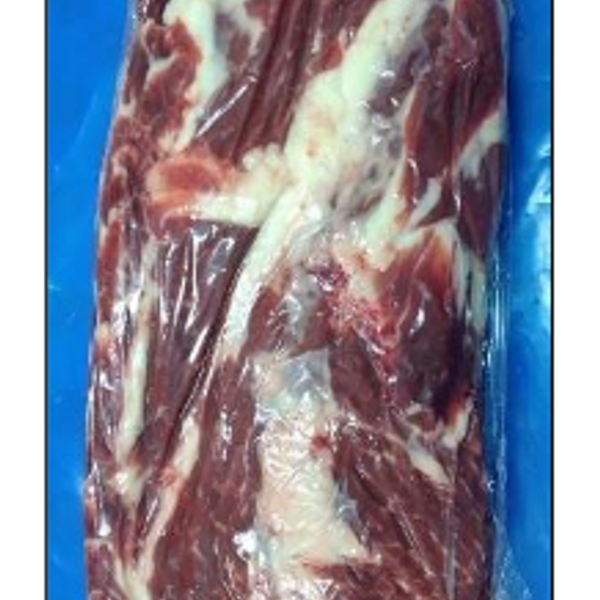
BIFE ANCHO SIN TAPA / CUBE ROLL CAP OFF. PREMIUM
El corte se obtiene de la región torácica de la media res. En sí, el corte es la continuación del bife
angosto, de 4 a 5 costillas (27 cm de largo máximo). Partiendo de un pecho, se realiza el desposte del
canal vertebral completo, se separan los cortes correspondientes al cuello, tronco y pecho, dejando
en la noria el miembro delantero. Ya en la cinta, el bife ancho es separado de la aguja y el cogote por
los charqueadores. El charqueador toma el bife, retira la tapa de bife junto al ligamento cervical (origen
del mismo) con cuidado para no marcar la superficie del corte y que quede la capa de grasa intacta,
luego se retira el cordón (restos del corte asado), se emprolijan o encuadran los extremos de manera
que queden bien rectos y en caso de ser necesario se perfila la pollera, una saliente del corte que
apoya sobre espinas de las vértebras. El corte resultante es de conformación o contextura buena o
muy buena a excelente. Se retiran los pelotones de grasa y se eliminan posibles colgajos, moretones,
ganglios, marcas de tinta y astillas de hueso que pudieran estar presentes en el corte.
The cut is obtained from the thoracic region of the half-carcass. The cut is, in fact, the continuation
of the striploin, from 4 to 5 ribs (maximum 27 cm long). Starting from a forequarter, the vertebral
channel deboning is carried out completely and the cuts belonging to the neck, trunk and brisket
are separated, leaving on the railway the forequarter member. Once on the conveyor belt, the cut
is separated from the chuck and neck. The cube roll cap is withdrawn along with the cervical
ligament. This operation is carried out carefully so that the cut’s surface is not marked and the
whole fat layer is kept on the cut. Then, the chain (remains of flank) is removed. The cut’s edges
are cut in a straight line in order to give the cut a square shape and, if necessary, the projection of
the cut that rests on the spines of the vertebrae (“pollera”) is neatly trimmed. The cube roll’s eye
must have a good or very good to excellent conformation. Fat balls, flaps, bruises, ganglia, ink
stains and bone dust that could be present on the cut are removed
angosto, de 4 a 5 costillas (27 cm de largo máximo). Partiendo de un pecho, se realiza el desposte del
canal vertebral completo, se separan los cortes correspondientes al cuello, tronco y pecho, dejando
en la noria el miembro delantero. Ya en la cinta, el bife ancho es separado de la aguja y el cogote por
los charqueadores. El charqueador toma el bife, retira la tapa de bife junto al ligamento cervical (origen
del mismo) con cuidado para no marcar la superficie del corte y que quede la capa de grasa intacta,
luego se retira el cordón (restos del corte asado), se emprolijan o encuadran los extremos de manera
que queden bien rectos y en caso de ser necesario se perfila la pollera, una saliente del corte que
apoya sobre espinas de las vértebras. El corte resultante es de conformación o contextura buena o
muy buena a excelente. Se retiran los pelotones de grasa y se eliminan posibles colgajos, moretones,
ganglios, marcas de tinta y astillas de hueso que pudieran estar presentes en el corte.
The cut is obtained from the thoracic region of the half-carcass. The cut is, in fact, the continuation
of the striploin, from 4 to 5 ribs (maximum 27 cm long). Starting from a forequarter, the vertebral
channel deboning is carried out completely and the cuts belonging to the neck, trunk and brisket
are separated, leaving on the railway the forequarter member. Once on the conveyor belt, the cut
is separated from the chuck and neck. The cube roll cap is withdrawn along with the cervical
ligament. This operation is carried out carefully so that the cut’s surface is not marked and the
whole fat layer is kept on the cut. Then, the chain (remains of flank) is removed. The cut’s edges
are cut in a straight line in order to give the cut a square shape and, if necessary, the projection of
the cut that rests on the spines of the vertebrae (“pollera”) is neatly trimmed. The cube roll’s eye
must have a good or very good to excellent conformation. Fat balls, flaps, bruises, ganglia, ink
stains and bone dust that could be present on the cut are removed
Boneless
Fresh
As per customer's request
Origin
아르헨티나
Production Capacity
1 /

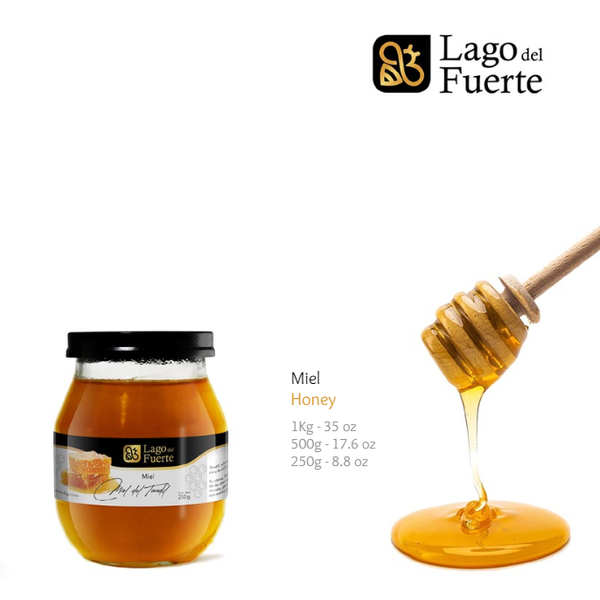
Honey (Miel)
Tandil, the ideal setting for beekeeping.
Its climate, flora and the natural setting
of the oldest mountains in the world,
allow to obtain a unique,
high-quality honey.
Its climate, flora and the natural setting
of the oldest mountains in the world,
allow to obtain a unique,
high-quality honey.
Origin
아르헨티나
Production Capacity
1,600 /
Export Volume
1,599 /
Recommended suppliers for you
By clicking “Accept Cookies,” I agree to provide cookies for statistical and personalized preference purposes. To learn more about our cookies, please read our Privacy Policy.
/200x200/company-logo/49/b5/42/49b542245422b4f180442cb39db2ad9e2bd419e8/DALLE_2024-03-28_11.16.04_-_A_second_variant_of_a_luxurious_and_professional_company_logo_this_time_featuring_a_more_abstract_representation_of_a_globe_in_emerald_green__255133_1_2.png)